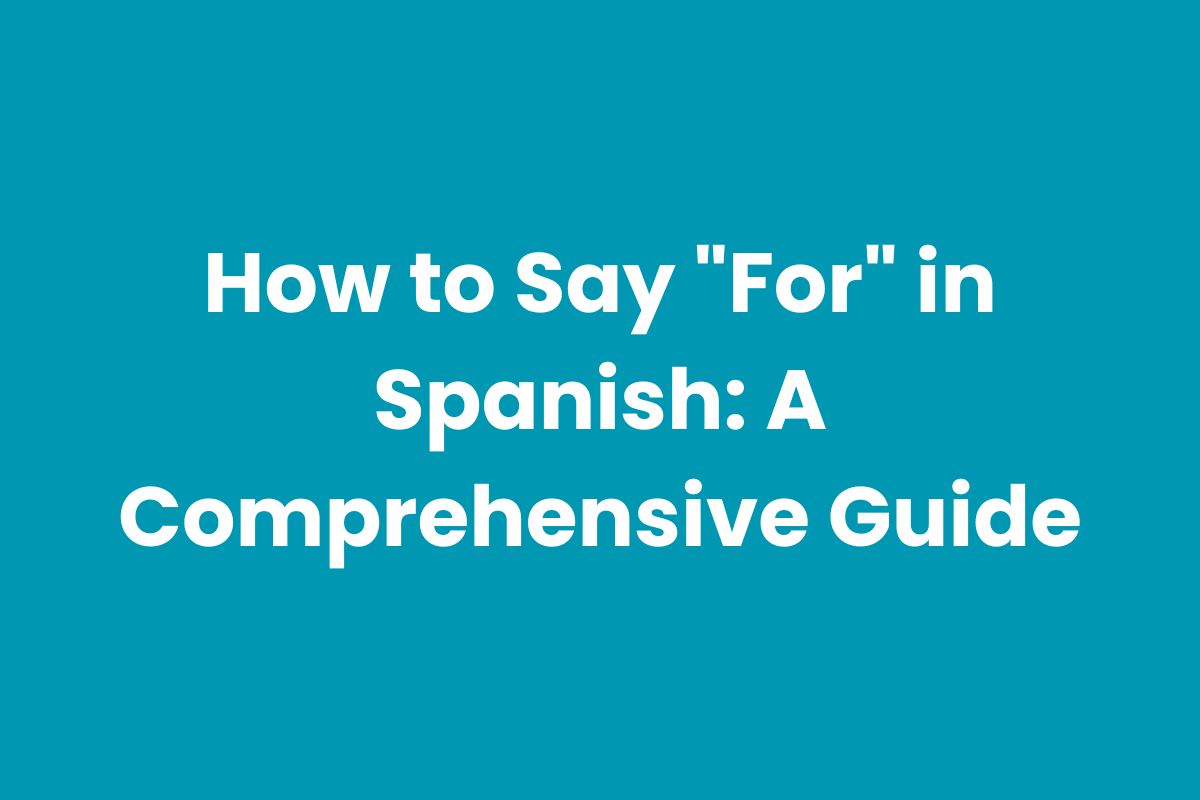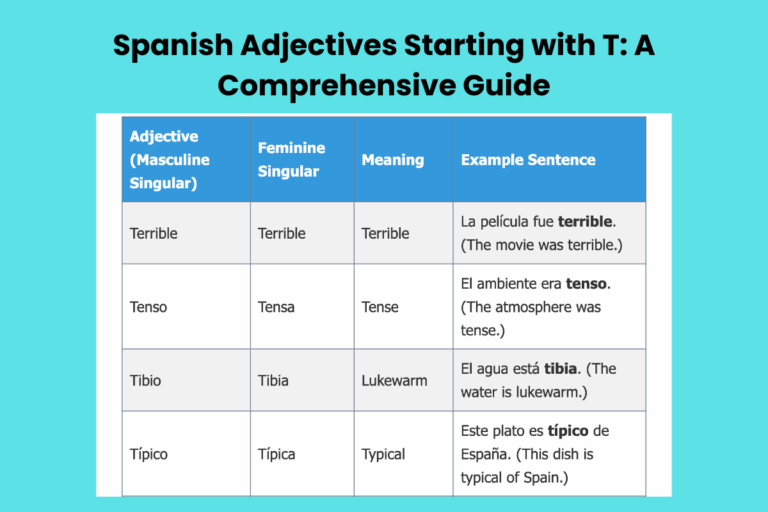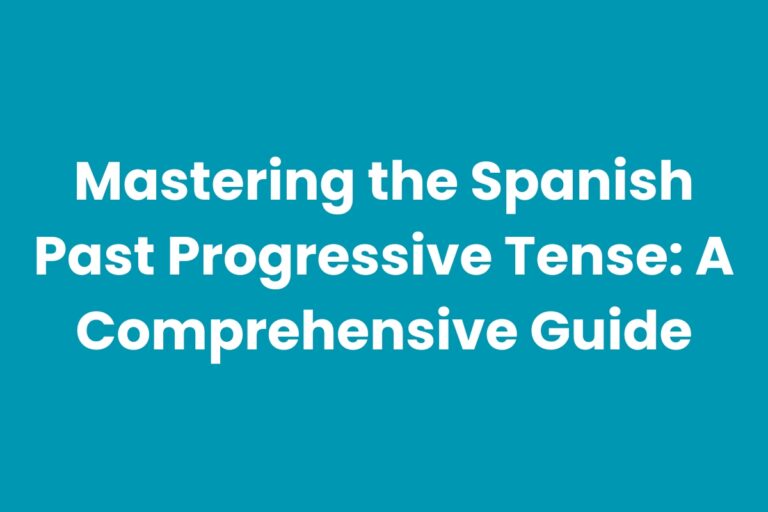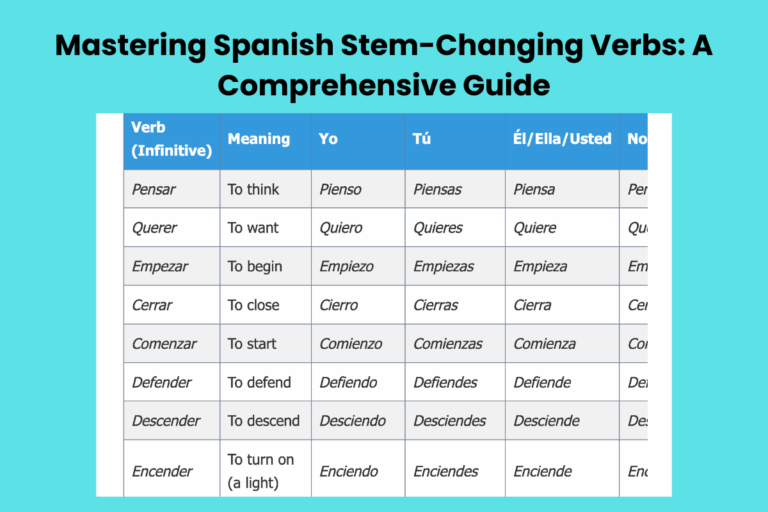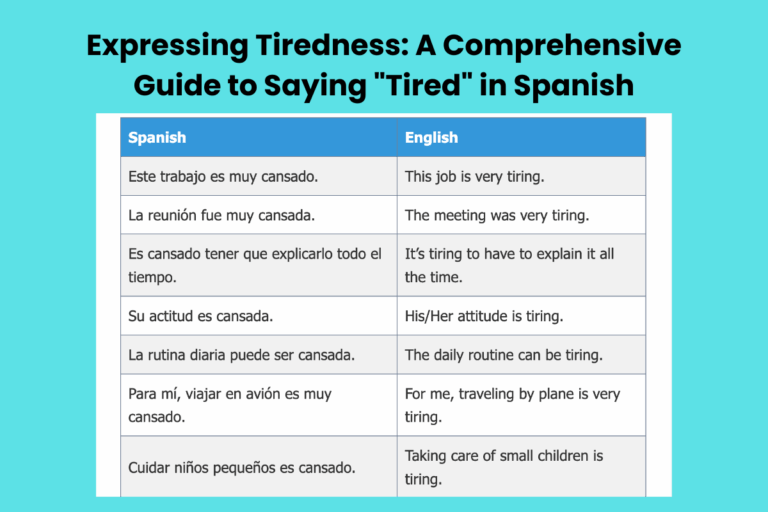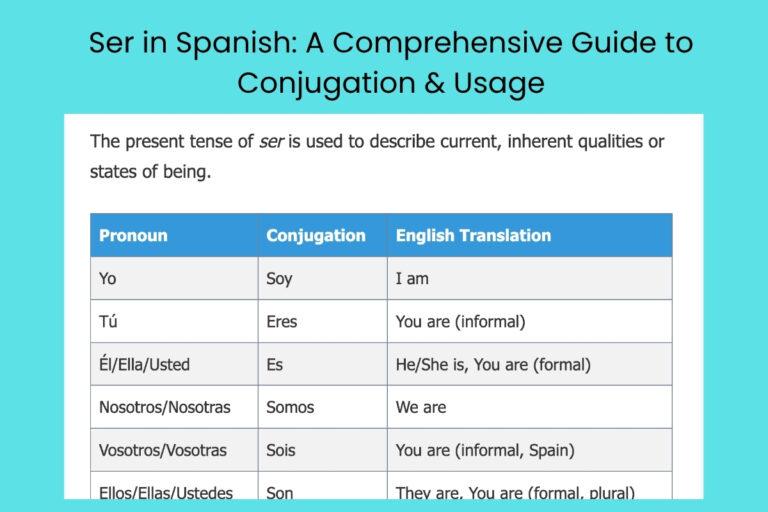How to Say “For” in Spanish: A Comprehensive Guide
Mastering the nuances of expressing “for” in Spanish is crucial for achieving fluency and accuracy. Unlike English, which primarily uses “for,” Spanish employs multiple prepositions to convey the various meanings and contexts of “for.” This comprehensive guide breaks down the different ways to express “for” in Spanish, including para, por, a, en, and others, depending on the intended meaning. This article is designed for Spanish learners of all levels, from beginners to advanced speakers, who want to refine their understanding and application of these essential prepositions. By understanding when and how to use each preposition correctly, learners can significantly improve their communication skills and avoid common errors, ensuring clarity and precision in their Spanish.
Table of Contents
- Introduction
- Definition of “For” in Spanish
- Structural Breakdown
- Types and Categories
- Examples
- Usage Rules
- Common Mistakes
- Practice Exercises
- Advanced Topics
- FAQ
- Conclusion
Definition of “For” in Spanish
The English word “for” is a versatile preposition with multiple meanings, indicating purpose, reason, duration, recipient, and more. In Spanish, there isn’t a single equivalent; instead, different prepositions are used depending on the specific context. The most common translations are para and por, but a, en, de and según can also be used in certain situations. Understanding the nuances of each preposition is crucial for accurate and natural-sounding Spanish.
The choice of preposition dictates the intended meaning. For instance, para often indicates a destination, purpose, or recipient, while por typically signifies a cause, reason, or duration. Mastering these distinctions is key to avoiding common errors and expressing yourself clearly in Spanish. The correct usage depends heavily on the context within the sentence.
Structural Breakdown
The structure involving “for” in Spanish typically involves a preposition followed by a noun, pronoun, or infinitive verb. The preposition connects the element it precedes to the rest of the sentence, indicating the relationship between them.
The structure is generally:
Preposition + Noun/Pronoun/Infinitive
For example:
- Para + el viaje (for the trip)
- Por + el dinero (for the money)
- A + mí (for me)
- En + verano (for summer)
- De + caridad (for charity)
- Según + mi opinión (for my opinion)
The specific structure may vary slightly depending on the verb and other elements in the sentence, but this basic pattern is fundamental. Understanding this structure helps in constructing grammatically correct and meaningful sentences in Spanish.
The preposition chosen depends entirely on the context of the sentence and the intended meaning.
Types and Categories
Para
Para is used to express:
- Destination: Where someone or something is going.
- Purpose: The reason for doing something.
- Recipient: Who something is for.
- Deadline: A specific time or date.
- Comparison: Expressing a contrast or comparison.
- Employment: Indicating who someone works for.
Por
Por is used to express:
- Cause/Reason: The reason why something happened.
- Duration: How long something lasts.
- Exchange: Trading one thing for another.
- Route/Path: The way to get somewhere.
- Agent (Passive Voice): Who performed an action.
- Means/Mode: How something is done.
A
A is used to express:
- Indirect Object: To whom or for whom an action is done.
- Time: At a specific time.
- Manner: In what manner something is done.
- Price: At a certain price.
En
En is used to express:
- Time (Seasons): During seasons.
- Means of Transportation: How one travels.
- General Time Periods: During broad periods.
De
De is used to express:
- Material: What something is made of.
- Origin: Where someone or something is from.
- Content: What something contains.
- Purpose: For a specific purpose (less common than para).
Según
Según is used to express:
- According to: Based on someone’s opinion or statement.
Examples
Examples with Para
The following table provides examples of how para is used in different contexts. Each example illustrates a specific usage of para, such as destination, purpose, recipient, deadline, comparison, and employment. Understanding these examples will help you grasp the versatility of para and its importance in Spanish communication.
| Spanish Sentence | English Translation | Category |
|---|---|---|
| Voy para Madrid. | I’m going to Madrid. | Destination |
| Estudio para ser médico. | I study to be a doctor. | Purpose |
| Este regalo es para ti. | This gift is for you. | Recipient |
| Necesito el informe para mañana. | I need the report for tomorrow. | Deadline |
| Para ser tan joven, es muy inteligente. | For being so young, he is very intelligent. | Comparison |
| Trabajo para una empresa grande. | I work for a big company. | Employment |
| Compré flores para mi madre. | I bought flowers for my mother. | Recipient |
| El vaso es para agua. | The glass is for water. | Purpose |
| Salgo para la estación en cinco minutos. | I’m leaving for the station in five minutes. | Destination |
| Para un principiante, habla muy bien español. | For a beginner, he speaks Spanish very well. | Comparison |
| Este libro es para aprender español. | This book is for learning Spanish. | Purpose |
| La carta es para el director. | The letter is for the director. | Recipient |
| Tenemos que terminar el proyecto para el viernes. | We have to finish the project by Friday. | Deadline |
| Para un niño, es muy alto. | For a child, he is very tall. | Comparison |
| Ella trabaja para el gobierno. | She works for the government. | Employment |
| Compré pan para la cena. | I bought bread for dinner. | Purpose |
| Estas galletas son para los niños. | These cookies are for the children. | Recipient |
| El informe debe estar listo para el lunes. | The report must be ready by Monday. | Deadline |
| Para ser tan viejo, está muy en forma. | For being so old, he is very fit. | Comparison |
| Él trabaja para una organización benéfica. | He works for a charity. | Employment |
| Necesito papel para escribir. | I need paper for writing. | Purpose |
| Este mensaje es para ti solamente. | This message is for you only. | Recipient |
| La tarea es para el miércoles. | The homework is for Wednesday. | Deadline |
Examples with Por
The following table provides examples of how por is used in various contexts. These examples cover cause/reason, duration, exchange, route/path, agent (passive voice), and means/mode. Understanding these diverse applications of por is essential for mastering its usage and differentiating it from para.
| Spanish Sentence | English Translation | Category |
|---|---|---|
| Lo hice por ti. | I did it for you (because of you). | Cause/Reason |
| Estudié por tres horas. | I studied for three hours. | Duration |
| Te doy esto por aquello. | I give you this for that. | Exchange |
| Pasamos por el parque. | We passed through the park. | Route/Path |
| Fue escrito por Cervantes. | It was written by Cervantes. | Agent (Passive Voice) |
| Hablamos por teléfono. | We talked on the phone. | Means/Mode |
| Gracias por tu ayuda. | Thank you for your help. | Cause/Reason |
| Viví allí por un año. | I lived there for a year. | Duration |
| Cambié mi coche por una moto. | I exchanged my car for a motorcycle. | Exchange |
| Caminamos por la playa. | We walked along the beach. | Route/Path |
| La casa fue construida por mi abuelo. | The house was built by my grandfather. | Agent (Passive Voice) |
| Envié el paquete por correo aéreo. | I sent the package by airmail. | Means/Mode |
| Estoy preocupado por su salud. | I am worried about his health. | Cause/Reason |
| Trabajé por ocho horas hoy. | I worked for eight hours today. | Duration |
| Compré la camisa por veinte dólares. | I bought the shirt for twenty dollars. | Exchange |
| Viajamos por toda Europa. | We traveled throughout Europe. | Route/Path |
| El concierto fue organizado por la escuela. | The concert was organized by the school. | Agent (Passive Voice) |
| Nos comunicamos por correo electrónico. | We communicate by email. | Means/Mode |
| Siento mucho lo que pasó por mi culpa. | I’m very sorry for what happened because of me. | Cause/Reason |
| Esperé por él durante una hora. | I waited for him for an hour. | Duration |
| Intercambié mi libro por el suyo. | I exchanged my book for his. | Exchange |
| Corrimos por el bosque. | We ran through the forest. | Route/Path |
| La obra fue pintada por Picasso. | The work was painted by Picasso. | Agent (Passive Voice) |
Examples with A
The following table illustrates the usage of a in different contexts, including indirect objects, time, manner, and price. Each example provides a clear demonstration of how a functions in these various scenarios, helping you to understand its specific role in Spanish grammar.
| Spanish Sentence | English Translation | Category |
|---|---|---|
| Le di el libro a Juan. | I gave the book to Juan. | Indirect Object |
| La clase empieza a las ocho. | The class starts at eight. | Time |
| Lo hizo a propósito. | He did it on purpose. | Manner |
| Vendí mi coche a buen precio. | I sold my car at a good price. | Price |
| Escribí una carta a mi amigo. | I wrote a letter to my friend. | Indirect Object |
| Llegaré a las cinco. | I will arrive at five. | Time |
| Lo hizo a la ligera. | He did it lightly. | Manner |
| Compré las manzanas a un euro el kilo. | I bought the apples at one euro per kilo. | Price |
| Dije la verdad a mi padre. | I told the truth to my father. | Indirect Object |
| Nos vemos a las diez. | We’ll see each other at ten. | Time |
| Lo hizo a escondidas. | He did it secretly. | Manner |
| Vendimos la casa a un precio razonable. | We sold the house at a reasonable price. | Price |
| Envié un regalo a mi hermana. | I sent a gift to my sister. | Indirect Object |
| La reunión es a las tres de la tarde. | The meeting is at three in the afternoon. | Time |
| Lo resolvió a la perfección. | He resolved it perfectly. | Manner |
| Compramos el coche a un precio muy alto. | We bought the car at a very high price. | Price |
| Presté dinero a mi primo. | I lent money to my cousin. | Indirect Object |
| Empezamos a trabajar a las nueve. | We started working at nine. | Time |
| Lo hizo a regañadientes. | He did it reluctantly. | Manner |
| Alquilamos el apartamento a un precio justo. | We rented the apartment at a fair price. | Price |
Examples with En
The following table presents examples of en used to indicate time (seasons), means of transportation, and general time periods. These examples demonstrate how en is employed to specify when or how something occurs, providing a clear understanding of its role in denoting time and means.
| Spanish Sentence | English Translation | Category |
|---|---|---|
| En verano hace mucho calor. | In summer it is very hot. | Time (Seasons) |
| Viajo en tren. | I travel by train. | Means of Transportation |
| En el siglo XXI, la tecnología avanza rápidamente. | In the 21st century, technology advances rapidly. | General Time Periods |
| Me gusta nadar en verano. | I like to swim in the summer. | Time (Seasons) |
| Voy en bicicleta al trabajo. | I go to work by bicycle. | Means of Transportation |
| En mi juventud, viajé mucho. | In my youth, I traveled a lot. | General Time Periods |
| Los árboles florecen en primavera. | The trees bloom in spring. | Time (Seasons) |
| Prefiero viajar en avión. | I prefer to travel by plane. | Means of Transportation |
| En la Edad Media, la vida era muy diferente. | In the Middle Ages, life was very different. | General Time Periods |
| En otoño las hojas cambian de color. | In autumn the leaves change color. | Time (Seasons) |
| Voy en coche al supermercado. | I go to the supermarket by car. | Means of Transportation |
| En el futuro, viviremos en Marte. | In the future, we will live on Mars. | General Time Periods |
Examples with De
The following table showcases examples of de used to indicate material, origin, content, and purpose. These examples highlight the varied applications of de, providing a clear understanding of its role in specifying what something is made of, where it comes from, what it contains, or its intended use.
| Spanish Sentence | English Translation | Category |
|---|---|---|
| La mesa es de madera. | The table is made of wood. | Material |
| Soy de España. | I am from Spain. | Origin |
| Un vaso de agua. | A glass of water. | Content |
| Máquina de escribir. | Typewriter. | Purpose |
| La camisa es de algodón. | The shirt is made of cotton. | Material |
| Ella es de Argentina. | She is from Argentina. | Origin |
| Una botella de vino. | A bottle of wine. | Content |
| Traje de baño. | Swimsuit. | Purpose |
| El anillo es de oro. | The ring is made of gold. | Material |
| Él es de México. | He is from Mexico. | Origin |
| Un plato de sopa. | A plate of soup. | Content |
| Coche de carreras. | Race car. | Purpose |
Examples with Según
The following table provides examples of how según is used to indicate “according to.” These examples demonstrate how según is employed to attribute information or opinions to specific sources, helping you understand its role in citing and referencing information.
| Spanish Sentence | English Translation | Category |
|---|---|---|
| Según el periódico, mañana lloverá. | According to the newspaper, it will rain tomorrow. | According to |
| Según mi opinión, es una buena idea. | According to my opinion, it’s a good idea. | According to |
| Según los expertos, la economía mejorará. | According to the experts, the economy will improve. | According to |
| Según mi madre, debo estudiar más. | According to my mother, I should study more. | According to |
| Según el pronóstico del tiempo, hará sol. | According to the weather forecast, it will be sunny. | According to |
| Según los rumores, se casarán pronto. | According to the rumors, they will get married soon. | According to |
Usage Rules
Usage Rules for Para
Destination: Use para to indicate the destination of a person or object.
Example: Salgo para la oficina. (I’m leaving for the office.)
Purpose: Use para to express the purpose or reason for doing something.
Example: Estudio para ser ingeniero. (I study to be an engineer.)
Recipient: Use para to indicate who or what something is intended for.
Example: Este regalo es para ti. (This gift is for you.)
Deadline: Use para to specify a deadline or a point in time by which something must be done.
Example: Necesito el informe para el lunes. (I need the report by Monday.)
Comparison: Use para to express a comparison or contrast.
Example: Para ser un niño, es muy alto. (For a child, he is very tall.)
Employment: Use para to state who someone works for.
Example: Trabajo para una empresa internacional. (I work for an international company.)
Usage Rules for Por
Cause/Reason: Use por to indicate the cause or reason for something.
Example: Lo hice por ti. (I did it for you/because of you.)
Duration: Use por to express the length of time something lasts.
Example: Estudié por dos horas. (I studied for two hours.)
Exchange: Use por to indicate an exchange or substitution.
Example: Te doy mi libro por el tuyo. (I give you my book for yours.)
Route/Path: Use por to describe a route or path.
Example: Caminamos por el parque. (We walked through the park.)
Agent (Passive Voice): Use por to indicate the agent in a passive sentence.
Example: La casa fue construida por mi padre. (The house was built by my father.)
Means/Mode: Use por to describe the way something is done or the means by which something is accomplished.
Example: Hablamos por teléfono. (We talked on the phone.)
Usage Rules for A
Indirect Object: Use a before the indirect object of a verb.
Example: Di el libro a mi hermano. (I gave the book to my brother.)
Time: Use a to indicate the time at which something happens.
Example: La reunión es a las tres. (The meeting is at three o’clock.)
Manner: Use a to indicate the manner in which something is done.
Example: Lo hizo a propósito. (He did it on purpose.)
Price: Use a to indicate price.
Example: Vendí mi coche a buen precio (I sold my car at a good price.)
Usage Rules for En
Time (Seasons): Use en to indicate seasons.
Example: En verano hace calor. (In summer, it’s hot.)
Means of Transportation: Use en to indicate means of transportation.
Example: Viajo en tren. (I travel by train.)
General Time Periods: Use en to refer to general time periods.
Example: En el siglo XXI… (In the 21st century…)
Usage Rules for De
Material: Use de to indicate the material something is made of.
Example: La mesa es de madera. (The table is made of wood.)
Origin: Use de to indicate origin or where someone is from.
Example: Soy de España. (I am from Spain.)
Content: Use de to indicate the content of something.
Example: Un vaso de agua. (A glass of water.)
Purpose: Use de to indicate purpose. (Less common than para).
Example: Máquina de escribir. (Typewriter.)
Usage Rules for Según
According to: Use según to indicate something is based on someone’s opinion or statement.
Example: Según mi opinión… (According to my opinion…)
Common Mistakes
One of the most common mistakes is using para and por interchangeably. Remember that para generally indicates purpose, destination, or recipient, while por is used for cause, duration, or exchange.
| Incorrect | Correct | Explanation |
|---|---|---|
| Estudio por ser médico. | Estudio para ser médico. | Para is used to express purpose. |
| Gracias para tu ayuda. | Gracias por tu ayuda. | Por is used to express the reason for gratitude. |
| Voy por Madrid. | Voy para Madrid. | Para is used to indicate destination. |
| Lo compré para veinte dólares. | Lo compré por veinte dólares. | Por is used to indicate exchange. |
| Necesito el informe por mañana. | Necesito el informe para mañana. | Para is used to indicate a deadline. |
| Trabajo por una empresa. | Trabajo para una empresa. | Para is used to indicate employment. |
Another common mistake is omitting the preposition a before an indirect object.
Incorrect: Di el libro Juan. Correct: Di el libro a Juan.
Using en instead of por to indicate means.
Incorrect: Hablamos en teléfono. Correct: Hablamos por teléfono.
Practice Exercises
Exercise 1: Para vs. Por
Choose the correct preposition (para or por) to complete each sentence.
| Question | Answer |
|---|---|
| 1. Estudio _____ ser profesor. | para |
| 2. Gracias _____ tu ayuda. | por |
| 3. Voy _____ la playa. | para |
| 4. Lo hice _____ ti. | por |
| 5. Necesito el libro _____ mañana. | para |
| 6. Caminamos _____ el parque. | por |
| 7. Trabajo _____ una empresa grande. | para |
| 8. Compré el regalo _____ mi madre. | para |
| 9. Estudié _____ tres horas. | por |
| 10. Pasamos _____ la tienda. | por |
Exercise 2: Fill in the Blanks
Fill in the blanks with the appropriate preposition (para, por, a, en, de, or según).
| Question | Answer |
|---|---|
| 1. Le di el regalo _____ mi hermana. | a |
| 2. _____ mi opinión, es una buena película. | Según |
| 3. El vaso es _____
madera. |
de |
| 4. Viajo _____ tren. | en |
| 5. Necesito el informe _____ el viernes. | para |
| 6. Lo hice _____ ti. | por |
| 7. Nos vemos _____ las cinco. | a |
| 8. _____ verano, hace mucho calor. | En |
| 9. Soy _____ España. | de |
| 10. Gracias _____ tu ayuda. | por |
Exercise 3: Translation
Translate the following sentences into Spanish, paying attention to the correct use of prepositions.
| English Sentence | Spanish Translation |
|---|---|
| 1. I study to be a doctor. | Estudio para ser médico. |
| 2. Thank you for your help. | Gracias por tu ayuda. |
| 3. The class starts at eight. | La clase empieza a las ocho. |
| 4. In summer, it is very hot. | En verano, hace mucho calor. |
| 5. The table is made of wood. | La mesa es de madera. |
| 6. According to the newspaper, it will rain. | Según el periódico, lloverá. |
| 7. I am going to Madrid. | Voy para Madrid. |
| 8. I did it for you. | Lo hice por ti. |
| 9. I gave the book to my brother. | Di el libro a mi hermano. |
| 10. I travel by train. | Viajo en tren. |
Advanced Topics
Delving deeper into the nuances of using “for” in Spanish involves understanding idiomatic expressions and regional variations. Some expressions may not directly translate and require a more contextual interpretation.
For example, the phrase “estar para” can mean “to be about to” or “to be in the mood for,” which extends beyond the simple translation of “for.”
Additionally, certain regions may have preferences for using one preposition over another in specific contexts. Being aware of these subtleties can enhance your fluency and make your Spanish sound more natural and authentic.
It is essential to listen to native speakers and observe how they use these prepositions in various situations.
FAQ
How do I know when to use “para” vs. “por”?
Para is generally used for destination, purpose, recipient, and deadlines, while por is used for cause, duration, exchange, and route. Consider the context and intended meaning to choose the appropriate preposition.
Can “a” ever mean “for”?
Yes, “a” can mean “for” when used as an indirect object pronoun, indicating to whom or for whom an action is performed.
Is “de” commonly used to mean “for”?
De is less commonly used to mean “for” compared to para or por, but it can be used to indicate purpose or material in certain contexts.
What does “según” mean?
Según means “according to” and is used to attribute information or opinions to a specific source.
Are there regional differences in the usage of these prepositions?
Yes, certain regions may have preferences for using one preposition over another in specific contexts, so it’s beneficial to be aware of these variations.
Conclusion
Mastering the use of “for” in Spanish requires a comprehensive understanding of various prepositions, including para, por, a, en, de, and según. Each preposition has specific contexts and usage rules that must be carefully considered to ensure accurate and effective communication. By studying examples, understanding usage rules, and practicing regularly, Spanish learners can confidently navigate the nuances of these prepositions and avoid common mistakes.
Continue to immerse yourself in the Spanish language through reading, listening, and speaking, and pay close attention to how native speakers use these prepositions in different situations. With dedication and practice, you’ll be able to express the various meanings of “for” in Spanish with precision and fluency, enhancing your overall language skills.

